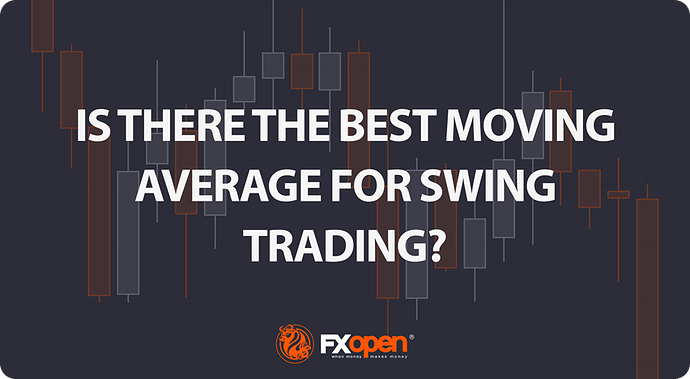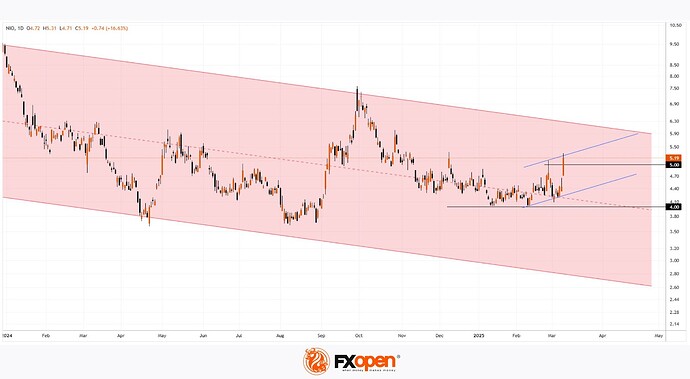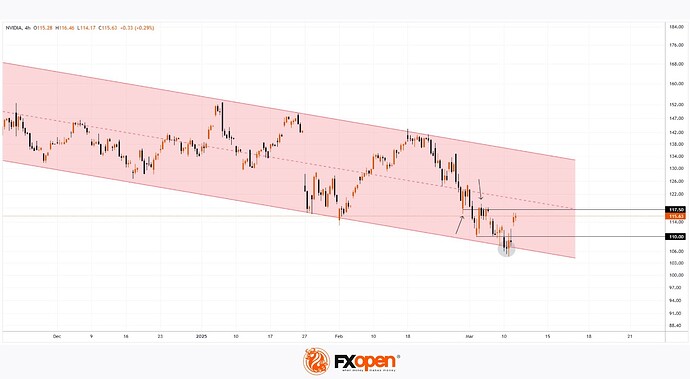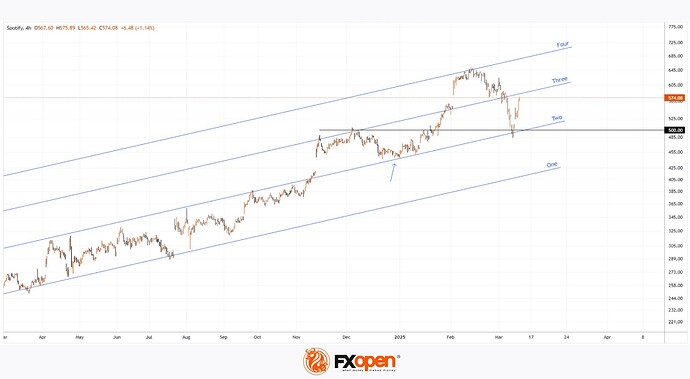Broadcom Inc. (AVGO) Stock Surges Over 8%
As shown on the chart, Broadcom Inc. (AVGO) shares soared by more than 8% in Friday’s trading session.
The bullish momentum is driven by strong quarterly results released last week and an optimistic outlook highlighting sustained demand in the artificial intelligence sector:
→ Earnings per share: $1.60 (Analyst forecast: $1.49)
→ Revenue: $14.92 billion (Expected: $14.61 billion), reflecting a 25% increase from $11.96 billion a year earlier.
TO VIEW THE FULL ANALYSIS, VISIT FXOPEN BLOG
Disclaimer: This article represents the opinion of the Companies operating under the FXOpen brand only (excluding FXOpen EU). It is not to be construed as an offer, solicitation, or recommendation with respect to products and services provided by the Companies operating under the FXOpen brand, nor is it to be considered financial advice.
Market Insights with Gary Thomson: 10 - 14 March
Market Insights with Gary Thomson: US Inflation Rate and Producer Price Index, BoC Interest Rate
In this video, we’ll explore the key economic events, market trends, and corporate news shaping the financial landscape. Get ready for expert insights into forex, commodities, and stocks to help you navigate the week ahead. Let’s dive in!
In this episode, we discuss:
— US Inflation Rate
— BoC Interest Rate Decision
— US Producer Price Index
Don’t miss out—gain insights to stay ahead in your trading journey.

Watch it now and stay updated with FXOpen.
Don’t miss out on this invaluable opportunity to sharpen your trading skills and make informed decisions.
Disclaimer: This article represents the opinion of the Companies operating under the FXOpen brand only (excluding FXOpen EU). It is not to be construed as an offer, solicitation, or recommendation with respect to products and services provided by the Companies operating under the FXOpen brand, nor is it to be considered financial advice.
Is There the Best Moving Average (MA) To Use in Swing Trading?
In swing trading, moving averages are essential tools, helping traders identify trends, analyse market movements, and spot potential turning points. This article explores the most commonly used moving averages, their unique characteristics, and how they’re applied in trading strategies.
What Are Moving Averages?
You definitely know what moving averages are. However, we need to start our article with a brief introduction to this market analysis tool.
A moving average (MA) is a fundamental tool in technical analysis that helps traders understand the direction of a market trend by smoothing out price fluctuations, often touted among the best indicators for swing trading. Instead of focusing on the volatile ups and downs, MAs calculate an average of prices over a specific period, such as 20, 50, or 200 periods. This gives traders a clearer picture of the overall trend by filtering out short-term volatility.
TO VIEW THE FULL ANALYSIS, VISIT FXOPEN BLOG
Disclaimer: This article represents the opinion of the Companies operating under the FXOpen brand only (excluding FXOpen EU). It is not to be construed as an offer, solicitation, or recommendation with respect to products and services provided by the Companies operating under the FXOpen brand, nor is it to be considered financial advice.
Nasdaq 100 Enters Correction
As shown on the Nasdaq 100 (US Tech 100 mini on FXOpen) index chart today:
→ The index has fallen below the psychological 20,000-point level, reaching its lowest in approximately six months.
→ The decline from the December peak now exceeds 10%, officially marking the start of a correction.
Why the Nasdaq 100 Is Falling Today
Bearish sentiment stems from a combination of factors, including (according to Zacks analysts):
→ The Trump administration’s tariff policies and their potential economic impact. Concerns increased after the latest jobs report showed unemployment rising from 4.0% to 4.1%.
→ Worries about AI investment costs and their long-term profitability.
→ Market anticipation of tomorrow’s Consumer Price Index (CPI) release at 15:30 GMT+3.
TO VIEW THE FULL ANALYSIS, VISIT FXOPEN BLOG
Disclaimer: This article represents the opinion of the Companies operating under the FXOpen brand only (excluding FXOpen EU). It is not to be construed as an offer, solicitation, or recommendation with respect to products and services provided by the Companies operating under the FXOpen brand, nor is it to be considered financial advice.
Tesla (TSLA) Shares Drop Over 15%
Among the biggest decliners in the technology stock index (we covered the reasons behind the Nasdaq 100’s drop earlier this morning) are Tesla (TSLA) shares, which have plummeted by more than 15% in a single day—their worst performance in five years.
Why Tesla (TSLA) Shares Fell
One of the key bearish drivers behind Tesla’s stock decline appears to be Elon Musk’s political involvement in the Trump administration. For investors, this could signal concerns that:
→ The CEO is not devoting enough attention to the automaker’s operations.
→ Discontent among those who oppose Musk’s political stance could slow Tesla’s sales.
And what about Musk himself? He has:
→ Acknowledged that business is “tough,” particularly following a cyberattack on his social media platform, X, but stated he intends to focus on politics for at least another year.
→ Reassured investors that, in the long run, “everything will be fine.”
TO VIEW THE FULL ANALYSIS, VISIT FXOPEN BLOG
Disclaimer: This article represents the opinion of the Companies operating under the FXOpen brand only (excluding FXOpen EU). It is not to be construed as an offer, solicitation, or recommendation with respect to products and services provided by the Companies operating under the FXOpen brand, nor is it to be considered financial advice.
What Is the McClellan Oscillator (NYMO) and How to Use It in Trading?
The McClellan Oscillator is a widely used market breadth indicator that helps traders analyse momentum and market strength. It focuses on the relationship between advancing and declining stocks, offering unique insights beyond price movements. This article explains how the McClellan Oscillator works, its interpretation, and how it compares to other tools.
What Is the McClellan Oscillator?
The McClellan Oscillator is a market breadth indicator that traders use to measure momentum in stock market indices. It’s calculated based on the Advance/Decline Line, which tracks the net number of advancing stocks (those rising in price) minus declining stocks (those falling in price) over a given period.
The NYSE McClellan Oscillator is the most common variant, often called the NYMO indicator. However, it can also be applied to any other stock index, like the Dow Jones, Nasdaq, or FTSE 100.
TO VIEW THE FULL ANALYSIS, VISIT FXOPEN BLOG
Disclaimer: This article represents the opinion of the Companies operating under the FXOpen brand only (excluding FXOpen EU). It is not to be construed as an offer, solicitation, or recommendation with respect to products and services provided by the Companies operating under the FXOpen brand, nor is it to be considered financial advice.
Market Analysis: GBP/USD Rallies While EUR/GBP Gains Strength
GBP/USD is showing bullish signs above the 1.2870 zone. EUR/GBP is gaining pace and might extend its upward move above the 0.8445 zone.
Important Takeaways for GBP/USD and EUR/GBP Analysis Today
· The British Pound is gaining pace above the 1.2870 zone against the US Dollar.
· There is a connecting bullish trend line forming with support at 1.2925 on the hourly chart of GBP/USD at FXOpen.
· EUR/GBP started a fresh increase above the 0.8360 resistance zone.
· There is a major bullish trend line forming with support at 0.8402 on the hourly chart at FXOpen.
GBP/USD Technical Analysis
On the hourly chart of GBP/USD at FXOpen, the remained in a positive zone above the 1.2560 level. The British Pound formed a base and started a fresh increase against the US Dollar, as mentioned in the previous analysis.
The pair gained pace for a move above the 1.2715 and 1.2760 resistance levels. The pair even settled above the 1.2900 level and the 50-hour simple moving average.
TO VIEW THE FULL ANALYSIS, VISIT FXOPEN BLOG
Disclaimer: This article represents the opinion of the Companies operating under the FXOpen brand only (excluding FXOpen EU). It is not to be construed as an offer, solicitation, or recommendation with respect to products and services provided by the Companies operating under the FXOpen brand, nor is it to be considered financial advice.
Dollar Correction: Market Focus on US Inflation Data and Bank of Canada Meeting
The US dollar is trading with mixed dynamics. It is strengthening against commodity currencies, while suffering significant losses against the yen and European currencies. Today, US inflation data is expected, which could provide further clues on the future direction of major currency pairs.
USD/CAD
Investors and market participants have likely stopped paying attention to Donald Trump’s threats of tariffs on Canadian goods. Initially, the tariffs were set to be introduced in February, then postponed to early March, and later to April. In response, the Canadian government announced counter-tariffs and a boycott of certain US goods. As a result of these conflicting developments, the USD/CAD pair remains within a medium-term trading range between 1.4500 and 1.4300.
Technical analysis of USD/CAD suggests a potential retest of the lower boundary at 1.4300, as a bearish “doji” pattern was formed yesterday.
If buyers manage to consolidate above 1.4500, the pair could continue its upward movement towards recent highs around 1.4730–1.4600.
TO VIEW THE FULL ANALYSIS, VISIT FXOPEN BLOG
Disclaimer: This article represents the opinion of the Companies operating under the FXOpen brand only (excluding FXOpen EU). It is not to be construed as an offer, solicitation, or recommendation with respect to products and services provided by the Companies operating under the FXOpen brand, nor is it to be considered financial advice.
Apple (AAPL) Share Price Drops Over 7% in Two Days
As previously reported, AAPL shares had their worst January since 2008, but the challenges for investors have continued. The Apple (AAPL) stock chart shows that:
Yesterday, the price dropped below $218 during trading—the lowest level since September last year.
Compared to Friday’s closing price, the decline over the first two days of this week amounted to approximately 7.7%.
Why Has AAPL Stock Fallen?
Yesterday, we noted that bearish sentiment was prevailing in the stock market, leading the Nasdaq 100 index into correction territory. Market conditions were further dampened by news that Apple had delayed the release of an AI-powered update for its digital assistant, Siri 2.0, increasing selling pressure.
What Could Happen Next?
TO VIEW THE FULL ANALYSIS, VISIT FXOPEN BLOG
Disclaimer: This article represents the opinion of the Companies operating under the FXOpen brand only (excluding FXOpen EU). It is not to be construed as an offer, solicitation, or recommendation with respect to products and services provided by the Companies operating under the FXOpen brand, nor is it to be considered financial advice.
NIO Share Price Soars by Approximately 17%
The stock chart of Chinese electric vehicle manufacturer NIO shows that its price has reached a new high for 2025, following a 10% surge yesterday.
In the process, the stock formed a wide bullish gap and successfully broke through the psychological $5 per share level.
Why Has NIO’s Share Price Risen?
The bullish sentiment is largely driven by anticipation of the company’s upcoming earnings report. Last year, NIO achieved record-breaking monthly EV deliveries, reaching 31,000 units in December.
Investors are now eagerly awaiting further details about NIO’s two new mass-market brands, Onvo and Firefly. Onvo has already launched, while pre-orders for Firefly—a compact and intelligent EV priced at around $20,500—have begun.
Additionally, some investors may be shifting capital from TSLA shares (which have been experiencing a bearish trend, as reported yesterday) into NIO stock.
TO VIEW THE FULL ANALYSIS, VISIT FXOPEN BLOG
Disclaimer: This article represents the opinion of the Companies operating under the FXOpen brand only (excluding FXOpen EU). It is not to be construed as an offer, solicitation, or recommendation with respect to products and services provided by the Companies operating under the FXOpen brand, nor is it to be considered financial advice.
What You Should Know About the Japanese Yen
Among the plethora of currencies traded in the global market, the Japanese yen (JPY) holds a unique and significant position. In this article, we will delve into what forex traders need to know about the Japanese yen, from its historical significance to the factors affecting its price.
Understanding the Japanese Yen (JPY)
The Japanese yen, denoted as JPY, is the official currency of Japan. It is identified by its symbol ¥. The significance of the JPY in the forex market is derived from its reputation as a major reserve currency and its popularity in carry trades. The history of the JPY dates back to 1871 when the Meiji government, as part of its modernisation efforts, adopted the yen as the country’s official currency to replace the previous system. In 1882, the Bank of Japan (BOJ) was established. Over the years, the JPY has maintained its status as one of the world’s most traded currencies.
VIEW FULL ANALYSIS VISIT - FXOpen Blog…
Disclaimer: This article represents the opinion of the Companies operating under the FXOpen brand only (excluding FXOpen EU). It is not to be construed as an offer, solicitation, or recommendation with respect to products and services provided by the Companies operating under the FXOpen brand, nor is it to be considered financial advice.
Nvidia (NVDA) Share Price Rises Over 6%
The NVDA stock chart shows that following yesterday’s trading session, the share price climbed over 6%, outperforming the Nasdaq 100 index (US Tech 100 mini on FXOpen), which gained just over 1%.
Despite this recovery from a six-month low, NVDA shares remain down 15% year-to-date.
Why Did Nvidia (NVDA) Shares Rise Yesterday?
Positive sentiment swept through the stock market after U.S. inflation data came in lower than expected. The Consumer Price Index (CPI) for the month stood at 0.2%, below analyst forecasts of 0.3% and the previous reading of 0.4%.
Investors may now be looking for opportunities following the March sell-off, triggered by Trump’s tariff policies and recession fears—and NVDA shares appear attractive in this context.
Barron’s suggests that NVDA stock may currently be undervalued, while MarketWatch cites BofA analyst Vivek Arya, who advises investors to focus on Nvidia’s gross profit margins as a key driver of significant share price growth.
TO VIEW THE FULL ANALYSIS, VISIT FXOPEN BLOG
Disclaimer: This article represents the opinion of the Companies operating under the FXOpen brand only (excluding FXOpen EU). It is not to be construed as an offer, solicitation, or recommendation with respect to products and services provided by the Companies operating under the FXOpen brand, nor is it to be considered financial advice.
Euro and Pound Strengthen to Strategic Levels
The chaos brought by Donald Trump to the US economy, introducing tariffs on China, Canada, and Mexico, has contributed to the strengthening of the euro, pound, and Swiss franc. The situation remained unchanged even after the release of US inflation data yesterday. According to the published figures, the core consumer price index declined more than analysts had forecast (2.8% versus 2.9%). In the long run, this may lead to an earlier Fed rate cut and a continued downward movement in the dollar.
EUR/USD
The euro has been strengthening for more than two consecutive weeks and is currently trading near last year’s October highs at 1.0950–1.0920. With the right news impulse, the price may break yesterday’s highs and test the psychological resistance level at 1.1000.
Yesterday, a “bearish harami” pattern formed on the daily timeframe. If confirmed, EUR/USD may start a downward correction towards 1.0830–1.0760.
TO VIEW THE FULL ANALYSIS, VISIT FXOPEN BLOG
Disclaimer: This article represents the opinion of the Companies operating under the FXOpen brand only (excluding FXOpen EU). It is not to be construed as an offer, solicitation, or recommendation with respect to products and services provided by the Companies operating under the FXOpen brand, nor is it to be considered financial advice.
Williams Alligator Strategies
The Bill Williams Alligator indicator has become a mainstay in many traders’ toolkits. Utilising three moving averages to create the Alligator’s jaws, teeth, and lips, it provides deep insight into trends and potential reversals. This article breaks down the Alligator, offering three comprehensive strategies to leverage it effectively.
Understanding the Bill Williams Alligator
The Alligator, a Bill Williams indicator, is a powerful tool in financial trading, offering insights into market trends and potential turning points. Conceptualised by renowned trader Bill Williams, the Alligator is grounded in the notion that markets move in a rhythmic pattern, akin to the predatory behaviour of an alligator.
This indicator employs three smoothed moving averages, each named after parts of an alligator: the ‘Jaw’ (13-period), ‘Teeth’ (8-period), and ‘Lips’ (5-period). These moving averages are displaced into the future, adding a dynamic and predictive element to the analysis.
VIEW FULL ANALYSIS VISIT - FXOpen Blog…
Disclaimer: This article represents the opinion of the Companies operating under the FXOpen brand only. It is not to be construed as an offer, solicitation, or recommendation with respect to products and services provided by the Companies operating under the FXOpen brand, nor is it to be considered financial advice.
Gold Price Nears $3,000 for the First Time in History
As shown in the XAU/USD chart today, gold is at a record high, just $5 away from the key psychological level of $3,000. Moreover, on the futures market, COMEX data indicates that gold futures have already surpassed this barrier.
Bullish sentiment is driven by:
→ Low US inflation data (released on Wednesday), which boosted gold prices due to growing expectations of a more dovish Federal Reserve policy.
→ Uncertainty surrounding Trump’s tariffs, escalating global trade tensions. According to the latest reports, the US president has warned of a 200% tariff on European wine and other alcoholic beverages after the EU imposed a 50% tariff on American whiskey.
TO VIEW THE FULL ANALYSIS, VISIT FXOPEN BLOG
Disclaimer: This article represents the opinion of the Companies operating under the FXOpen brand only (excluding FXOpen EU). It is not to be construed as an offer, solicitation, or recommendation with respect to products and services provided by the Companies operating under the FXOpen brand, nor is it to be considered financial advice.
Intel (INTC) Shares Surge by Approximately 14%
As shown in the Intel (INTC) stock chart:
→ Trading opened yesterday with a strong bullish gap.
→ By the end of the session, shares had risen by approximately 14% compared to the previous day’s closing price.
According to Dow Jones Market Data, INTC shares recorded their largest percentage gain since 13 March 2020, making them the top-performing stock in the S&P 500 index (US SPX 500 mini on FXOpen) on Thursday.
Why Did Intel (INTC) Shares Rise?
The surge followed the company’s announcement of a new CEO appointment. Lip-Bu Tan, a former board member, has been named the new Chief Executive Officer, set to assume the role on 18 March. Investors reacted positively to the decision, as Tan previously achieved significant success as CEO of Cadence Design Systems.
As the Wall Street Journal put it:
“Lip-Bu Tan is Intel’s best hope for a turnaround—if Intel can be fixed at all.”
TO VIEW THE FULL ANALYSIS, VISIT FXOPEN BLOG
Disclaimer: This article represents the opinion of the Companies operating under the FXOpen brand only (excluding FXOpen EU). It is not to be construed as an offer, solicitation, or recommendation with respect to products and services provided by the Companies operating under the FXOpen brand, nor is it to be considered financial advice.
What Is Dollar-Cost Averaging (DCA) in Investing and Trading?
Dollar-cost averaging (DCA) is a popular strategy used by investors and traders to manage market fluctuations and build positions over time. Instead of trying to time the market, DCA focuses on consistent, regular investments regardless of price movements. This article answers “What is DCA?”, its advantages and limitations, and how it can be applied in both investing and trading.
What Is Dollar-Cost Averaging (DCA)?
So what is DCA investing? Dollar-cost averaging (DCA) is a strategy that involves consistently investing a fixed sum at regular intervals, regardless of the asset’s current price. This approach helps distribute the cost of purchases over time, potentially reducing the impact of short-term price fluctuations. Instead of trying to time the market perfectly—a challenging task even for experienced traders—a dollar-cost averaging strategy focuses on regular contributions to average the cost of assets.
TO VIEW THE FULL ANALYSIS, VISIT FXOPEN BLOG
Disclaimer: This article represents the opinion of the Companies operating under the FXOpen brand only (excluding FXOpen EU). It is not to be construed as an offer, solicitation, or recommendation with respect to products and services provided by the Companies operating under the FXOpen brand, nor is it to be considered financial advice.
Market Insights with Gary Thomson: 17 - 21 March
Market Insights with Gary Thomson: Canada’s Inflation, Fed and BoE Interest Rates, Earnings Reports
In this video, we’ll explore the key economic events, market trends, and corporate news shaping the financial landscape. Get ready for expert insights into forex, commodities, and stocks to help you navigate the week ahead. Let’s dive in!
In this episode, we discuss:
— Canada’s Inflation Rate
— Fed Interest Rate Decision
— BoE Interest Rate Decision
— Corporate Earnings Reports
Don’t miss out—gain insights to stay ahead in your trading journey.

Watch it now and stay updated with FXOpen.
Don’t miss out on this invaluable opportunity to sharpen your trading skills and make informed decisions.
Disclaimer: This article represents the opinion of the Companies operating under the FXOpen brand only (excluding FXOpen EU). It is not to be construed as an offer, solicitation, or recommendation with respect to products and services provided by the Companies operating under the FXOpen brand, nor is it to be considered financial advice.
Spotify (SPOT) Shares Rise by Nearly 7%
According to the stock chart of music streaming giant Spotify (SPOT), the share price:
→ Increased by almost 7% by the end of trading on Friday.
→ Has surged approximately 28% since the start of 2025—one of the strongest performances in the stock market.
→ Has nearly doubled over the past 12 months.
Why Is Spotify (SPOT) Stock Rising?
As we noted late last year, investors have responded enthusiastically to the launch of the “Premium” plan, which offers higher-quality, ad-free music streaming and is expected to boost the company’s revenue.
Additionally, on Friday, Spotify announced that it had paid out around $10 billion in royalties to artists during 2024. By comparison, in 2014, this figure was “just” $1 billion.
TO VIEW THE FULL ANALYSIS, VISIT FXOPEN BLOG
Disclaimer: This article represents the opinion of the Companies operating under the FXOpen brand only (excluding FXOpen EU). It is not to be construed as an offer, solicitation, or recommendation with respect to products and services provided by the Companies operating under the FXOpen brand, nor is it to be considered financial advice.
S&P 500 Analysis: How Long Could the Stock Market Correction Last?
Six days ago, we noted that the Nasdaq 100 had entered a correction phase. Now, the S&P 500 (US SPX 500 mini on FXOpen) has followed suit, closing more than 10% below its 19 February peak on Thursday, officially confirming a correction.
Statistically, according to research by Yardeni Research:
→ Market corrections occur quite frequently—since 1929, the S&P 500 has experienced 56 corrections.
→ Only 22 of those corrections turned into bear markets, defined as a drop of 20% or more from recent record highs.
S&P 500 Analysis: How Long Could This Correction Last?
On one hand, Friday’s market rebound suggests that buyers are stepping in.
On the other hand:
→ US Treasury Secretary Scott Bessent stated on Sunday that there are “no guarantees” the world’s largest economy will avoid a recession. This came just a week after US President Donald Trump refused to rule out such a scenario.
→ The current correction has lasted 22 days so far, whereas historically, the average correction lasts 115 days and results in a 13.8% decline from the peak.
TO VIEW THE FULL ANALYSIS, VISIT FXOPEN BLOG
Disclaimer: This article represents the opinion of the Companies operating under the FXOpen brand only (excluding FXOpen EU). It is not to be construed as an offer, solicitation, or recommendation with respect to products and services provided by the Companies operating under the FXOpen brand, nor is it to be considered financial advice.
































